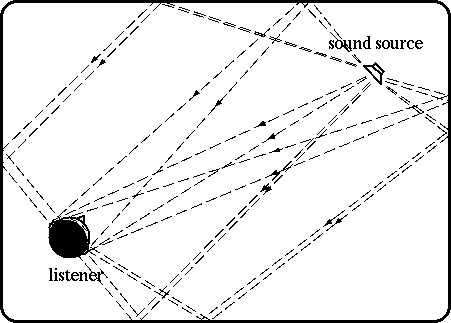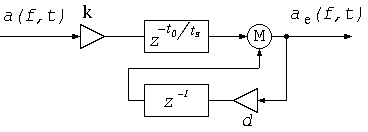
When the impulse response from the sound source to the ear is
defined as h(t), and the part caused by echoes
(removed the effect of the direct sound from the the impulse response)
is he(t).
The echoes of a sound signal s(t)
is given as
se(t) = he(t) * s(t).
Although the impulse response here is unknow, we can give an generalized
approximation which reflects the delay and decay features in the impulse response
ge = k e -(t-t0)/tau.
Here, the delay time t0 and decay factor tau are
chosen to match the most general cases in an ordinary environment.
(It is done by the learning effect in the human auditory systems.)
Thus, the echoes of a subband signal a(f,t)
(envelop of narrow-subband signal or amplitude of short-term Fourier transform)
can be estimated as
ae(f,t) = Max{a(f,t-t') ge(t')}
for 0 < t' < inf.
By using the exponential decay feature of the generalized impulse response,
the echo estimation algorithm can be implemented by a feed-back manner,
where ts is the sampling time interval
and d = e -ts/tou.

The following figure shows an example of echo estimation.



- Sound Source 1: Radio weather forecast
- Sound Source 2: Talk show with one male and one female host
Localization results in an anechoic chamber

Localization results in a normal room

- Huang, J. and Supaongprapa, T. and Terakura, I and Wang, F. and
Ohnishi, N. and Sugie, N.,
"A Model Based Sound Localization System and Its Application to
Robot Navigation",
Robotics and Autonomous Systems (Elsevier Science),
Vol.27, No.4, pp.199-209, 1999.
- Jie Huang, Noboru Ohnishi and Noboru Sugie,
"Sound Localization in Reverberant Environment based on the Model of
the Precedence Effect",
IEEE Trans. Instrumentation and Measurement,
Vol.46, No.4, pp.842-846, August 1997.